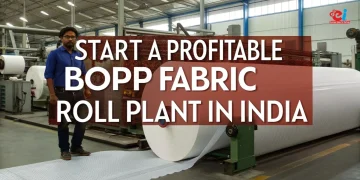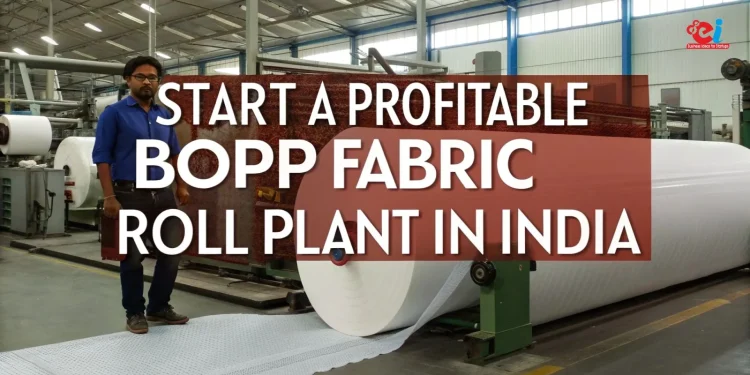Shifts in agriculture, logistics, retail, and food processing have increased the demand for advanced packaging solutions. As a result, BOPP fabric rolls have become increasingly important components in the industrial packaging landscape. BOPP stands for Biaxially Oriented Polypropylene, a type of plastic film that possesses strength and clarity along with being easily printable and moisture resistant. When applied to woven polypropylene fabric, the result is a strong, durable, and attractive packaging material used for producing bags to package fertilizer, sugar, grains, cement, seeds, animal feed, and other branded commodities. These BOPP-laminated woven sacks have become the preferred choice of many manufacturers for branding purposes where durability and moisture protection are critically important.
With a marked increase in need for these services, particularly in India, Africa, and Latin America, this has created a window of opportunity to invest in BOPP fabric roll manufacturing units. This may prove strategic for those wishing to pursue ventures in the manufacturing market, as this business model is ideal for meeting unwavering demand, having moderately volatile raw materials, and substantial potential for exports and sales domestically. Although promising, establishing such units requires precise planning of considerable complex technical and infrastructural choices.
Understanding the Product and Its Functional Role
BOPP fabric rolls are made by the lamination of BOPP film onto woven polypropylene (PP) fabric. Together with reinforcing the mechanical strength of the packaging material, the lamination enhances the appeal and barrier property of the material. BOPP film can be rotogravure printed with branding, instructions, and even compliance markings to aide in marketing before lamination. Then the fabric roll is either sold as-is to bag converters or further processed by in-house production into finished bags.
Advanced synthetic packaging materials such as BOPP-laminated fabric have high Functional advantages over older, conventional materials. In addition to being lightweight and easily stackable, it is also water resistant and practically tear-resistant. Agricultural and Industrial goods are protected from spoilage, infestation, and environmental factors which makes BOPP fabric the perfect choice for wrapping. With the added advantage of being reusable and recyclable, BOPP fabric emerges as an eco-friendly option throughout the entire packaging value chain.
Related: Recyclable Smart Fabrics: The Future of Sustainable Fashion Tech
Site Selection Alongside Developing Infrastructure
The initial steps in setting up a manufacturing facility for BOPP fabric is selecting a location that is logistically convenient, has easy access to suppliers of raw material, as well as electricity, water, and other utilities. Such locations include industrial zones next to petrochemical centers, as well as woven-sack production centers. They offer favorable positions for medium-sized units which typically allocate 25,000 to 40,000 square feet of floor space for extrusion, weaving, lamination, printing, slitting, packaging, and storage.
The structure should be built in a way that maximizes productivity and order in the workflow. In order to prevent cross contamination, the lamination and printing zones must be kept separate from the raw material intake area. The environments in which printing and lamination is performed must be kept clean and controlled to safeguard the sensitive nature of the products. The scope of work includes installation of proper airflow systems, fire protective systems, illumination, and electricity management systems from the ground up. For units dedicated to exports, meeting international construction and safety standards will offer additional advantages.
Technological Order of Operations and Equipment Needs
The process of producing BOPP fabric rolls is fully automated as it is composed of several sequential processes, each with a dedicated set of equipment. The first step consists of producing polypropylene tapes, where PP granules are heated to form a molten state, and extruded through a die to create tapes. These tapes then undergo a stretching and winding process on bobbins in preparation for weaving.
“Woven tubular fabric” is the result of the conversion of tapes into woven fabric by the circular looms in the weaving department. The fabric is ready for lamination. A BOPP film, which is either transparent or pre-printed, is attached to the woven fabric using dry lamination or extrusion lamination technique. A dry lamination machine bonds the film and the fabric using adhesives while in extrusion lamination, the film is bonded by melting resin to form a layer that binds the two materials. Both methods are valid, but each has specific product and client requirements.
After the dry Lamination step, the fabric undergoes a slit into predetermined widths which are optimal for downstream bag-making machines, or sent to converters waiting for shipment. Each roll produced undergoes a meticulous slitting process whereby quality inspection, tension control, and edge finishing are implemented to avoid wrinkles, misalignment, weak bonding and guarantee a flawless roll. If printing is done in-house, high-speed rotogravure printing capable of multi-color registration is installed prior to lamination.
In a fully integrated setup, the unit may also feature bag conversion lines with cutting, stitching, gusseting, and bottom-sealing machines. These devices produce BOPP-laminated woven bags from fabric rolls ready for sale. A number of units, however, only focus on fabric roll production and sell to bag manufacturers because that leads to greater focus on core operations and reduced capital expenditures.
Raw Material Sourcing and Supply Chain Management
Raw Material Sourcing and Supply Chain Management, including procurement policies, is the cornerstone of operations for manufacturing entities.
The most highly sought after input is high-quality raw supplies, which the business proponent needs to procure systematically. For BOPP woven bags, the primary component is virgin polypropylene resin which is utilized in tape extrusion processes. Other supporting materials are BOPP films (plain or pre-printed), inks for printing, adhesives for lamination, additives like UV stabilizers and anti-block agents. These inputs are usually procured from the petrochemical industry, chemical industries, or and direct importers.
Ensured and preset contracts aid in the preservation of competitive pricing with the suppliers which mitigate possible inflation threats. A concern arises, however, as pricing for polymer resins shift in equilibrium with global crude oil pricing, making shifts in costs a possible deciding factor for producers. In the fabrication cycle of the product, having an alternative vendor along with consistent stock helps lower at-risk frameworks.
To prevent bottleneck issues, effective logistics and warehouse management systems are required for supporting just-in-time production. Timely organization of supply chain planning which includes local and regional distribution networks helps enhance cost efficiency by minimizing transportation costs and ensures on time delivery to clients.
Related: Growth Opportunities in Production of Bopp Adhesive Tapes
Regulatory Framework and Quality Standards
BOPP fabric does need to comply with a myriad of industrial and environmental regulations even though it’s not categorized as pharmaceutical or food-grade item. The Factory needs to be registered under the Factories Act. Emissions and waste management operates with the State Pollution Control Board’s approval. In the case where power is generated with the help of diesel gensets, further compliance to air quality will be necessary.
Institutional clients often use ISO 9001 (Quality Management System) and ISO 14001 (Environmental Management) Certified Standards. For SEDEX compliance and REACH certified export units, addition of credibility is provided while ISO 22000 if it’s food related packaging, expands accessible markets for them.
Every stage requires the implementation of Quality Control protocols from testing raw materials, in-process inspections to the final roll test. Customer specifications need to be cross checked to make sure they are being met which requires controlling these parameters roll width, fabric GSM, lamination strength, print clarity and tear resistance. A well equipped in house lab with universal testing machines, tensile testers, GSM cutters, and thickness gauges is critical.
Business Model and Market Entry Strategy
A plant’s capacity and strategic position influences revenue channels in the BOPP fabric business. Manufacturers are able to operate on a B2B model by selling laminated fabric rolls to bag makers and converters. They may also sell roll to bulk consumers such as fertilizer companies, grain procurement agencies, sugar mills, and chemical manufacturers who do bag-making in-house.
In India, the agricultural economies in Punjab, Gujarat, Andhra Pradesh and Uttar Pradesh have high uptake of BOPP-laminated bags. Joining consortia for government procurement tenders, alliances with packaging distributors, and soliciting imprinting and branding services can significantly augment revenue streams.
Equally, exporting BOPP fabric rolls has lucrative prospects. Indian packaging materials are well-received in Africa, Middle East, and South east Asia for their cost efficiency and durability. Exporters should adhere to international product compliance and register with visibility templates such as DGFT, APEDA and IndiaMART. In this regard, shipping agents, freight forwarders, and third-party inspecting agencies become invaluable partners.
Business Capital and Financial Estimates
The investment needed for setting up a BOPP fabric manufacturing plant varies by its size and extent of automation. For instance, a medium-scale plant that produces 8–10 tonnes of laminated fabric per day is estimated to cost between ₹12 crore and ₹25 crore. This value encompasses the cost of purchasing machinery, infrastructure setting, civil construction, electrical setup, ETPs, working capital margin, and certifications.
The operational costs include raw materials, labor, utilities, maintenance, and logistics. Remember that raw materials will encompass 60–65 percent of the total operational costs. Upon successfully negotiating appropriate contracts for business operations and sales, a gross margin of 15 percent to 25 percent can be achieved. Depending on market forces and level of utilization of capacity, breakeven is usually obtained after three to four years.
Under MSME, Startup India, and CLCSS schemes, there is financial support available by way of term loans, working capital limits, and machinery finance. Gaining the approval of banks and investors is reliant on having a meticulously crafted Detailed Project Report (DPR).
Strategic Relevance of Professional Consulting
Due to the technical intricacies and the capital intensity associated with BOPP fabric manufacturing, execution risks can be mitigated with specialist consultancy. Such consultants offer integrated services like, market feasibility study, preparing project documents, plant layout design, sourcing of machinery, developing a quality system and marketing a firm, to name a few, like NPCS does.
Consultants for a venture help entrepreneurs avoid overinvestment, poor layout design, compliance oversights, and planning within capacity constraints. NPCS also prepares financial models, DPRs for loan applications and drafts required reports for other government incentive compliances.
Final Remark
BOPP fabric rolls are positioned as highly promisable in the industrial packaging market due to increasing demand for high endurance, print-ready and weatherproof packaging materials. Considering there’s a growing consciousness towards branding in bulk marketed goods in India and there’s global demand for eco-friendly packaging, India’s expansive agricultural economy is a locomotive for market growth.
Investment alone does not suffice in setting up a BOPP fabric manufacturing plant. It requires operational prowess, precise technical details, and consistent quality. Strategies designed with expert consultancy and meticulous implementation focused on quality tend to lead to enduring profitability and market precedence.


























